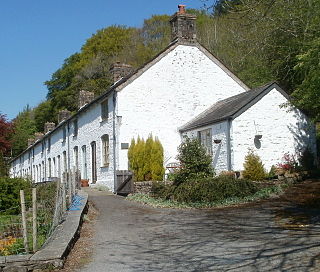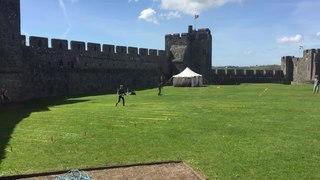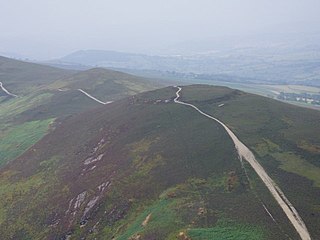
Caerleon is a town and community on the River Usk situated 5 miles (8 km) northeast of the city of Newport, Wales and 5.5 miles (9 km) southeast of Cwmbran. Caerleon is of archaeological importance, being the site of a notable Roman legionary fortress, Isca Augusta, and an Iron Age hillfort. Close to the remains of Isca Augusta are the National Roman Legion Museum and the Roman Baths Museum. The town also has strong historical and literary associations: Geoffrey of Monmouth elevated the significance of Caerleon as a major centre of British history in his Historia Regum Britanniae (c.1136), and Alfred Lord Tennyson wrote Idylls of the King (1859-1885) while staying in Caerleon.

Fairwater is a community and suburb of Cwmbran in the county borough of Torfaen, in south east Wales, and was built by the Cwmbran Development Corporation between 1963 and 1966.
Forge Side was the site of an ironworks started in 1836. The development was soon abandoned, but resumed in 1859. A settlement of houses was built for the workers.

Cwmavon is a hamlet about 2 miles south of Blaenavon and 4 miles north of Pontypool. The hamlet is part of the community of Abersychan in the county borough of Torfaen in south east Wales, and is within the boundaries of the historic county of Monmouthshire.

The Dyfed Archaeological Trust is one of the four Welsh Archaeological Trusts established in the mid-1970s with the charitable object 'to advance the education of the public in archaeology'. Its core area comprises Carmarthenshire, Ceredigion and Pembrokeshire in south-west Wales.
The Glamorgan-Gwent Archaeological Trust is an Archaeological Trust organisation established in 1975 as part of the Welsh Archaeological Trusts.

Moel y Gaer is an Iron Age hillfort on a summit of Llantysilio Mountain, northwest of the town of Llangollen, Denbighshire, Wales. The site is a scheduled monument classified as a prehistoric defensive hillfort.
Pen y Clawdd Castle is a ditched mound with a double moat, roughly circular in shape, with a diameter of approximately 28m to 30m and about 2.4m high. The castle is in Llanvihangel Crucorney, about five miles to the north of Abergavenny, Monmouthshire, in south east Wales and lies between the Usk and Monnow rivers. The mound was designated a scheduled monument in 1950 and described as a defensive medieval motte.

Burfa Castle is an Iron Age hillfort near the tiny town of Old Radnor, Radnorshire in Powys, Wales. The site is a scheduled monument described as a prehistoric defensive hillfort, and was included in an inventory of monuments by 1913. The site is near Offa's Dyke which passes near the bottom of Burfa Bank.
Llwynda-Ddu Camp, also known as Llwynda-Ddu Hillfort, is a small Iron Age earthwork in Pentyrch, Cardiff in South Wales. The site is a scheduled monument, described as a prehistoric, defensive hillfort.

Wenallt Camp, also known as Wenallt Enclosure, is an iron age enclosure near Rhiwbina, Cardiff, in South Wales, although some consider the camp a hillfort. The camp is a scheduled monument.

Gelligroes Mill is a water powered corn mill in Pontllanfraith, Caerphilly county borough, south Wales. It features an overshot wheel with a cast iron frame and wooden buckets. It was built around 1625, and much altered in its working life eventually falling into disuse in the late 1980s. It was soon restored and 1992. The mill was designated as a Grade II* listed building in 1962. It is believed to have been the last mill operating commercially in Monmouthshire.

Eglwys Newydd Church is an early 19th-century church which replaced a previous chapel of ease. The chapel of ease was originally at Trisant but was moved to this site around 1620 by the Herbert family, owners of the Hafod estate. The church was designated as a Grade II* listed building in 1964 for its historical connects with the Hafod estate and the quality of work of the remodelling in the 1930s.

Little Pitt Cottage is a medieval house in Llanarth, Monmouthshire, South Wales. It was designated a Grade II* listed building in 1956, its listing record describing it as a "fine and exceptionally intact timber-framed house".

Lamphey Court is a Greek revival mansion north of the village of Lamphey, Pembrokeshire, South Wales built in 1823 by Charles Delamotte Mathias from the profits of slavery on the tea plantations of Jamaica. It was designated in 1970 as an important Greek revival house of high architectural quality. After restorations and extensions Lamphey Court was re-opened by the present owners in 1980. It currently operates as a Best Western hotel.

Iscoyd Park is a three-storey redbrick country house in Wrexham County Borough, Wales. It has a slate roof built in the early 18th century. It was sold in 1737 to William Hanmer. The house and estate was then purchased by Philip Lake Godsal in 1843 and remains in the Godsal family to this day. Iscoyd was designated a Grade II* listed building in 1962 as a well-preserved country house. It supported by a range of 18th- and 19th-century service buildings including a park and gardens, outbuildings, coach house, corn house, kennels, laundry, piggery and stables. The dovecote has a pyramidal slate roof. The house is now run by Philip Langley Godsal and his wife Susie, who took over the house from his father Philip Caulfeild Godsal in 2009 and began a complete refurbishment. This was funded by operating as a wedding and events business but also remains the Godsal family home. Iscoyd Park has won various awards for the restoration of the house and outbuildings, including the Historic Houses Association and Sotheby’s Restoration Award, the Hudson’s Heritage Award for Best Wedding Venue, Hudson’s Heritage Award for Best Accommodation, Wales Gold Award for Best Services Accommodation, Bridebook’s Best National Wedding venue..

Rhydyn Hall, near Caergwrle in Flintshire, Wales, is an 18th-century building with two storeys with a later wing to the north-west. It has a slate roof, Doric porch and iron verandahs, and was designated a Grade II* listed building in 1962 as a good example of an early 18th century gentry house with good surviving interior detail.

Porth Wen Brickworks is a now disused Victorian brickworks which produced fire bricks, made from quartzite (silica) used to line steel-making furnaces. The substantial remains include a number of buildings and the remains of some of the machinery, but has some damage from sea erosion. The site is a scheduled monument.

Llanddona fish weir is a post medieval fish trap sited in Llanddona, on the Isle of Anglesey. The fish weir is a scheduled monument.

















